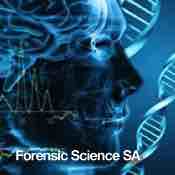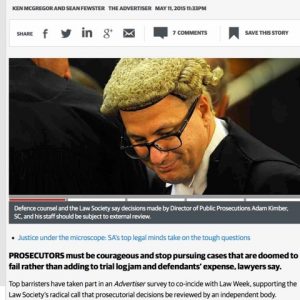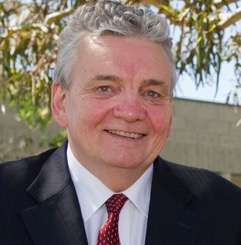Keogh trial ends: major inquiry needed
By Bill Rowlings, CEO of Civil Liberties Australia
The SA Director of Public Prosecutions, Adam Kimber, claims “illness” of a “key witness” as the reason for abandoning another trial of Henry Keogh for the alleged 1994 murder of his fiancee, Anna-Jane Cheney.
Keogh spent nearly 20 years in jail, but was freed after a special appeal under a new law in SA in late-2014.
ABC Radio has reported that the DPP said he had reviewed the case after “witness” Dr Colin Manock fell ill: Kimber said he believed “it was not appropriate to proceed without the witness giving evidence and being cross-examined”.
 Manock is no ordinary “witness”. He was the state’s former head forensic pathologist for nearly three decades. His indisposition may well be most convenient illness for a DPP in the state’s history.
Manock is no ordinary “witness”. He was the state’s former head forensic pathologist for nearly three decades. His indisposition may well be most convenient illness for a DPP in the state’s history.
The SA Supreme Court found in December 2014 that Manock had presented flawed evidence at Keogh’s original trial in 1995, causing him to spend nearly 20 years in jail wrongly convicted.
Manock’s repute is such – after trials, medical tribunal hearings, appeals, defamation cases, media interviews and the like – that it is incomprehensible that DPP Kimber could suggest Manock would have had credibility in court. If the SA DPP believes Manock was a potentially viable “key” witness, Kimber’s own judgement is seriously in question. ANy DPP misjudgement would simply be continuing the sorry performance over decades by the SA legal system that must now be examined by an open and transparent Royal Commission.
DPP Kimber has, for nearly a year, maintained the facade that Keogh could be charged again with murder over a probable accident. Both defence and the Crown’s own witnesses told a full Supreme Court appeals hearing in 2014 that Ms Cheney, alone in her home, almost certainly slipped in the bath, cracked her head and drowned accidentally in March 1994. Based on that evidence, the appeals court freed Keogh because the original jury verdict was unsafe. The Supreme Court ruled the conviction had been illegally achieved by using wrong and incompetent Crown forensic evidence, which was led by Manock.
Early in 2015, Kimber had made the inexplicable decision to re-prosecute Keogh, and a trial was set for March 2016.
DPP Kimber slipped back into the Supreme Court of SA before Justice Malcolm Blue at 4.30pm on Friday 13 Nov 2015, conveniently too late for widespread and detailed mass media coverage of his equivocal backdown. The DPP filed a nolle prosequi, a legal manoeuvre meaning the DPP has “voluntarily” decided to not proceed with the case.
His decision is unlikely to mitigate the massive state compensation due to Keogh, now 60, for the abuse of power heaped on him for at least 11 years by the legal system of the state of SA, by a state forensic system that was out of control before and after that, and by a political process that failed.
Civil Liberties Australia says the Crown in SA knew the likelihood that there was no murder – that the death was possibly, even probably an accident – as early as 2004. At least, if the justice system in SA had been functioning properly, the state’s Solicitors-General and Attorneys-General since 2004 should have known: an expert forensic report they themselves commissioned told them so. The report described a forensic test they could run to prove death was not deliberate by a handgrip, as described by Manock. The Crown failed to undertake that test.
The Crown also failed to give a copy of the report to Keogh, as legal rules required them to do. He languished in jail for a further 10 years, innocent, desperately trying to get his case back before an appeals court.
Keogh may receive around $10m compensation. He was jailed for life, with a 25-year minimum, in 1995 for murdering his fiancee by holding her head under water in the bath of the home they shared.
Many observers believe the case was tainted from the outset because the legal establishment was heavily invested in it. Ms Cheney was employed by the Law Society of SA, so it was a classic case of a “death in the family” for which “someone had to pay”, as frequently forms the plot in fiction and gangster movies. However, this was not fiction, but it became a nightmare for Keogh and for SA justice.
Keogh’s release in December 2014 was Australia’s first case under a new Right To Appeal law enacted in SA in mid-2013 and mirrored in Tasmania in November 2015. The same law should be passed in every state and territory, Civil Liberties Australia believes, to bring hidden injustices into the light of day.
When he re-charged Keogh in 2015, DPP Kimber knew – or should have known – the prospect of his achieving a fresh conviction of Keogh was close to zero because he would be unable to prove a murder had occurred. In fact, quite the opposite, because of what Crown witnesses had already told the Supreme Court. He allowed what many people believe was an empty, worthless charge to hang over Keogh’s head for most of 2015.
PHOTO: The Advertiser reported in May 2015 that DPP Kimber’s decisions about prosecuting in criminal cases should be subject to external monitoring, according to the SA Law Society,
The state government should now launch a Royal Commission into the state of justice in SA, covering:
- matters surrounding the Keogh and other questionable cases, including the non-charging of possible murderers, resulting from findings and evidence provided by Forensic Science SA and its predecessors;
- forensic science examinations, findings and evidence given in courts, tribunals and the like by Dr Colin Manock and state forensic science staff from 1968 to the present (including cases interstate where the SA forensic science services undertook examinations for external bodies, such as the NT government and its agencies, the Australian Federal Police, etc);
- actions, and inactions, by the Solicitors-General of SA, the Attorneys-General of SA, and other state entities involved in handling the legal appeals and petitions for mercy made by Henry Keogh and others between 1968 and the present;
- the ability or otherwise of professional tribunals, such as (but not only) those in forensics, medicine and law, to adequately “police” their professions and the members of them, including their speedy ability to prevent members continuing to operate in the profession, to protect the public, if adverse findings arise;
- the actions and inactions of the Office of the Director of Public Prosecutions in relation to the Keogh case and any other relevant cases; and
- any other matters relevant to the above.
Civil Liberties Australia believes there will be lessons for other states and territories in what the SA Royal Commissions finds.
BACKGROUND:
Manock headed the forensic science service in SA for about 30 years from 1968 until his retirement in late 1995, originally with no formal forensic pathology qualification, later with a questionable certificate provided by a professional association basically because he was the head man.
Over those three decades, forensic science expanded worldwide like no other branch of police or legal work.
Manock is believed to have handled more than 10,000 cases: about 400 involved alleged murders, including dozens where convictions were secured. In many other cases, Manock’s findings may have allowed guilty people to go free, including in three cases of possible “battered baby” syndrome.
Criticisms of Manock by his peers and lawyers over the years have included words like “unqualified”, “unreliable”, “dogmatic”, and “incompetent”. The High Court has used words like “discredited”, “speculative” and “unsupported by cogent evidence” in relation to him and his findings. A Royal Commission found his approach to an Indigenous death in custody to be “inappropriate” and his explanation “inadequate”. Manock has recanted key evidence he gave in some trials, including in that of Keogh.
These facts make it hard to fathom why SA DPP Kimber would ever have perceived Manock as a “key witness” in a proposed re-trial of Keogh.
Since about the turn of the century, a lone Adelaide legal academic, Dr Bob Moles, began pointing out that the forensic science and legal system in SA had gone “feral”, using the Keogh case as the prime – but by no means exclusive – example of how bad things were. Dr Moles built on work begun by Valeria Armfield, an Adelaide lawyer who first stood up for Keogh and who paid the price of about $50,000 in slander damages to the then head of the Law Society of SA.
To Moles belongs enormous credit for persisting in the face of disinterest and hostility by virtually all peers in academia and the law. If just a handful of them had shown Moles’ courage, the justice system in SA would be in much better shape today than the mess it is in.
Keogh’s release from jail is also to the great credit of the media, particularly Graham Archer, the producer/presenter on the TodayTonight show on Channel 7 in SA, but also to Sunday Mail for articles in 2000 and 2001, and ABC’s Four Corners, which first highlighted the problems with the SA forensic service in a major investigative program in 2001.
It is ironic that Channel 7 was also forced to pay damages for defamation to Manock over Today Tonight’s reporting of his activities. The payment occurred over a promo item, designed to draw the attention of as many South Australians as possible to the issue of how bad the state’s forensic and justice system might be!
The state government took no notice of any of these people who sounded thunderous alarm bells over a decade and a half. Now the taxpayers of the state will have to pay for the sins of omission of the people in high positions who were entrusted to deliver a fair justice system, and failed.
EXTRACTS from ABC Four Corners, in 2001 (repeat, 2001):
SALLY NEIGHBOUR: The coroner found that Dr Manock’s post-mortems had achieved the opposite of their purpose, by closing off lines of investigation rather that opening them up, and that serious crimes may have gone unpunished as a result.
Dr Manock retired from his position just before the coroner’s findings were released in 1995.
SALLY NEIGHBOUR: Before departing his post in Adelaide, Dr Manock helped the police secure one last major conviction.
NEWS REPORT: Henry Keogh was convicted of the murder of Anna Jane Cheney in August 1995.
It was an entirely circumstantial case.
Dr Manock was the key witness for the Crown.
His track record has sown seeds of doubt about the safety of the verdict and Keogh’s sentence of a minimum 25 years in jail.
NEWS REPORT: Dr Manock told the court, “I was at no time happy that the death was accidental because I could find no explanation as to why she would have drowned.”
SALLY NEIGHBOUR: Dr Manock would not be interviewed and would not discuss the details of any case.
So the bewildering questions about how he worked and how he reached his conclusions remain unanswered.
What is clear is that there’s much more in question than one man’s competence.
The much bigger question is how an entire system has let so many doubts go unresolved in so many cases for so many years.
KEVIN BORICK QC: I think you have to lay the blame directly with the legal profession and with the judiciary.
Speaking in response to questions on 13 November 2015, on the afternoon the DPP withdrew the case against Keogh, Dr Moles said he spoke briefly with Mr Keogh soon after the story broke at 11.20am on Advertiser.com.au
“We didn’t know that there was going to be any announcement before the court hearing this afternoon. So when we saw the item come up on The Advertiser website we were very, very pleased to see that it is now public information.
“There of course will be immense implications for the other cases that have involved the forensic pathologist in Henry’s case and I would like to think there would be a formal inquiry set up fairly soon to find out what’s been going on behind all of this.”
DPP Kimber released a statement after the withdrawal hearing saying that he reviewed the case after a key witness fell ill and believed “it was not appropriate to proceed without the witness (apparently Manock) giving evidence and being cross examined”.
“I concluded that essential matters would not be able to be proved unless the witness was called. I came to the view that there was no reasonable prospect of conviction without the witness.”
He said he would not name the witness because they were entitled to privacy. http://tinyurl.com/orpmchq Later the ABC reported that the DPP had named the witness as Manock.
If DPP Kimber believed over the past year that any “evidence” whatsoever given by Manock in 2016 would create a “reasonable prospect of conviction”, he may be the only lawyer in South Australia who would have been of that mind, Civil Liberties Australia says.



Yes let’s put Henry Keogh away for murder because she was at the plug end and the water level was low for someone with a back ache, genius logic there by Mark Griffin
the water level was way to low for response 1
A theory was that Anna had quickly stood up from/in the hot bath, and ‘passed out’, falling back into the bath. If that happened, she could have fallen with her head to either end of the bath. Here is a comment made on Q+A blog site which discusses how such falls occur:
The hot water dilates out your blood vessels and lowers your blood pressure. when you stand up, there isn’t enough blood return to your heart to shunt enough blood to your brain for a few seconds. So, the faint feeling is a result of the brain not getting the oxygen it needs to maintain consciousness.
why as the water level in the bath so low for someone with an ache back who really ran the bath why was anna at the plug end of the bath when the opposite end is where 99 percent sit
if it was assisted drowning in all logic the person who first found her a the plug end must have been the assistant